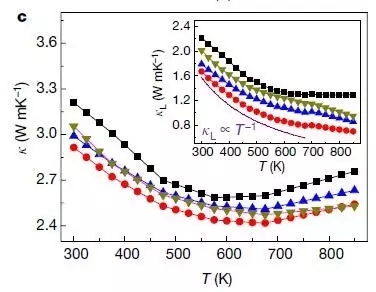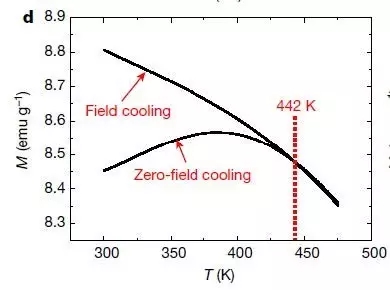Up-to-date Notice


Original Paper by the Research Team Led by Prof. Qingjie Zhang of Wuhan University of Technology Published Online in Nature
Original Paper by the Research Team Led by Prof. Qingjie Zhang of Wuhan University of Technology Published Online in Nature
The original paper by the Research Team led by Prof Qingjie Zhang, with the title “Superparamagnetic enhancement of thermoelectric performance”, was published online in the Journal Nature on September 14th, 2017. Their results demonstrated that by maipulating the thermal electromagnetic interactions caused by ferromagnetic vs superparamagnetic conversion of nanoparticles in thermoelectronic materials, they greatly enhanced the thermoelectric performance. This breakthrough overturned a universally held conviction that magnetic impurities were disadvantageous to electric transmission of semiconductors.
This research team just published another research paper in Journal Nature Nanotechnology a short time ago. They proposed that the magnetic transition of permanent magnet nanoparticles from ferromagnetism to paramagnetism provided an effective approach to suppress performance deterioration of thermoelectric materials in the intrinsic excitation region. It just took them less than a year to achieve another sensational breakthrough.
Thermoelectric materials can realize a reversible conversion of thermal and electrical energy, which can be widely applied in areas of recycling systems of thermal waste and solid state solutions for thermal management with a promising perspective. The most typical case in point is its application as the energy source for space probes Voyagers 1 & 2 launched by NASA. NASA just celebrated Voyager1's 40th birthday and the high reliability of thermoelectric performance of thermoelectric materials can be well proved by this 40-year-long history of persistent probing.

Space Probe Voyager 1
However, the commercial application of thermoelectric materials is rather limited in areas other than that of space probes. The reason lies in the thermoelectric figure of merit, i.e., the ZT value, which controls the thermoelectric conversion efficiency. A high ZT value requires a high ratio of electrical conductivity, SeeBeck coefficient, and a low ratio of thermal conductivity. Obviously, this is a paradox. By commonsense, we know that metals are good thermal and electrical conductors whereas porcelains are good thermal and electrical insulators. You can’t have it both ways. The fundamental reason is that charged carriers conduct heat as well as electricity. Therefore, the ratio of thermal conductivity of thermoelectric materials is the product of both carriers and phonons. Jeff Snyder illustrated the incompatibility of these three indicators by using the diagram below in his review paper in Journal Nature Materials.

The change of thermoelectric properties with that the density of carriers
That’s why research and development of thermoelectric materials moved in a very slow pace within the last a few decades. This hard development history of thermoelectric materials is clearly displayed by the diagram below in Mildred Dresselhaus’s review paper published in Nature Nanotechnology in 2013. The ZT value of thermoelectric materials remained almost the same in the last three decades of the 20th century without any improvement. However, with the discovery of nanostructure and a deepening understanding of thermoelectric laws of transmission, the 21st century witnessed a turning point. It also owes to the participation of a large number of Chinese scholars. The merit value ZT of thermoelectric materials increases considerably, even doubles, within the past one decade.

The developing trend of the thermoelectric merit value ZT
The previous strategies of thermoelectric effect improvement can be divided into two categories: one is to increase the phonon scattering and decrease the ratio of thermal conductivity, which can be realized by enlarging nanostructured surface area; the other is to regulate energy band structure and optimize the ratio of electrical to thermal conductivity and Seebeck coefficient. What’s more, it is conventionally held that magnetic impurities should be eliminated when preparing thermoelectric materials because they are disadvantageous to electricity transmission. This is the very conviction that the research team of Wuhan University of technology tries to overturns by their trailblazing proposal.
In their 2016 paper titled “Magnetoelectric interaction and transport behaviours in magnetic nanocomposite thermoelectric materials” published in the Journal Nature Nanotechnology, the research team of Wuhan University of Technology proposed to design and prepare magnetic nanocomposite thermoelectric materials consisting of BaFe12O19 hard magnetic nanoparticles and Ba0.3In0.3Co4Sb12 matrix. As shown in the figure below, they found that the density of carriers showed an irregular increase around 670 K with transition of BaFe12O19 from ferromagnetism to paramagnetism. With a careful analysis, our researchers has drawn a conclusion that with a temperature below 670 K, ferromagnetic nanoparticles behave as a micro magnetic field at nanometer scale, which cause the Lorentz force to affect moving electrons. Consequently, BaFe12O19 nanoparticles will trap charged carriers. While with a temperature above 670 K, the BaFe12O19 nanoparticles are in a paramagnetic state and the electrons trapped by Lorentz force will be released. Hence, the density of carriers will increase, which, in turn, will raise the Seebeck coefficient simultaneously. Meanwhile, the inclusion of nanoparticles lowers the thermal conductivity of phonons which will enhance the merit value ZT and therefore will suppress the deterioration of thermoelectric properties under the condition of a high temperature.
Nonetheless, as demonstrated in this newly published paper in Nature, they make the best out of the magnetic transition of permanent magnet nanoparticles from ferromagnetism to paramagnetism. The core methodology is: by preparing nanocomposite thermoelectric materials with nanoparticles of soft magnetic and by using thermoelectromagnetic interaction of the magnetic transition of soft magnet nanoparticles from ferromagnetism to superparamagnetism, they can achieve a multiple electron scattering formed by a quasi-Kondo effect which is caused by magnetic entropy rotations and electron spins under the superparamagnetic condition. Hence, the electrical transport properties are enhanced with an increased Seebeck coefficient and the thermal transport properties are optimized by the entailed phonon scattering which leads to lowered thermal conductivity and a higher Seebeck coefficient, simultaneously. Consequently, the difference of work functions between nanoparticles and thermoelectric materials causes magnetic nanoparticles to embed electrons in a thermoelectric matrix, and therefore, enhances density of carriers and electrical conductivity.
Therefore, with the micro mechanism shown in the figure below, magnetic nanoparticles have achieved a dual goal by enhancing electrical conductivity as well as the Seeback coefficient and reducing thermal conductivity, which can considerably increase the thermoelectric merit value ZT of thermoelectric materials with a maximum of 1.8.

The fantastic role of superparamagnetic nanoparticles: charge injection, multiple electron scattering and phonon scattering
How can our researchers achieve this magnificent mechanism shown in the above figure? An analysis of the Transmission Electron Microscope of the material’s microstructure clearly demonstrated in the figure below that Co nanoparticles in thermoelectric materials have formed some clusters of certain scale. The connectivity between the magnetic and thermoelectric properties can be embodied by the correlation curve between the transition from ferromagnetism to superparamagnetism and the change of temperature of thermal conductivity.



Microstructure of composite materials, thermal conductivity, and the transition from ferromagnetism to superparamagnetism of Co nanoparticles
The pioneering research work of Wuhan University of Technology also has brought forth an interesting proposition, that is, the regional connectivity between magnetic and thermoelectric transport properties at the nanoscale. At present, we still lack some effective means of directly measuring this connectivity. Advanced scanning probe microscopy techniques are likely to be quite promising in this area. Recently, a collaborated paper by Shenzhen Institutes of Advanced Technology Chinese Academy of Sciences and Washington University was published online in National Science Review with the title “Quantitative nanoscale mapping of three-phase thermal conductivities in filled skutterudites via scanning thermal microscopy”. This work realized the quantitative measurement of the connectivity of thermal conductivity and microstructure of composite materials (shown in the figure below). With a combination of regional measurement based on magnetic force microscopy, it is highly probable to achieve a direct revelation about the influential rules of magnetic transition of nanoparticles on phonon and electron scattering as well as the characteristics of charge injection when nanoparticles are embedded in the thermoelectric matrix.

The imaging of the thermal conductivity, morphology and composite structures of three-phase composite materials
The first author of these two papers by Wuhan University of Technology is Professor Wenyu Zhao and the corresponding authors are Professor Qingjie Zhang of Wuhan University of Technology and Professor Jihui Yang of Washington University, respectively.